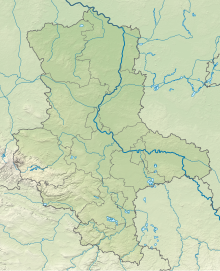Muldetalhang Rösa
Coordinates: 51 ° 36 ′ 58 ″ N , 12 ° 27 ′ 25 ″ E
The Muldetalhang Rösa is a nature reserve in the municipality of Muldestausee in the Anhalt-Bitterfeld district in Saxony-Anhalt .
The nature reserve with the registration number NSG 0274 is around 65 hectares in size. It is largely part of the FFH area "Muldeaue above Pouch" and completely surrounded by the "Muldeaue Pouch-Schwemsal" conservation area. The area has been under protection since 2006 (date of regulation: March 27, 2006). It replaces the approximately 61.5 hectare nature reserve "Steilhang des Muldetales", which was designated in autumn 1992. The responsible lower nature conservation authority is the district of Anhalt-Bitterfeld.
The nature reserve is located west of Rösa on the edge of the Dübener Heide nature park . It comprises an exposed, approximately 20-meter-high steep slope as a transition from the Dübener Heide to the Muldetal and upstream areas in the Muldetal with the Schlobach (also Mühlgraben) and slope ditch running here, as well as a polder on the Schlobach slightly above its confluence with the Mulde . The nature reserve is around 3000 meters long and mostly around 100 to 200 meters wide.
The slope areas of the steep slope are forested. Here near-natural beech forests with hornbeams , individual beeches , ash, English oak , winter linden , sycamore and field maple as well as white elm and field elm grow . The beech forests are pronounced in the area of the dry slope shoulders as hornbeam-elm slope forest and on deeper slope areas star chickweed, pedunculate oak-hornbeam forest . The beech forests have a high proportion of old and dead wood and a species-rich shrub layer . Of particular importance are the spring bloomers of the herb layer with arum , woodruff , yellow and wood anemone , Turk's knot , musk herb , lungwort, single berry , spring flat pea , psyllium, sweet milkweed and woolly buttercup . In the transition area to the valley floor, black and gray alder stocks grow . In the middle of the nature reserve, a water-feather alder swamp is formed on peaty ground. In the south-facing strip of the nature reserve, which ends in the polder area behind the wall of the hollow, remains of an ash-elm alluvial forest with dense, sloe-shaped, forest-mantle bushes grow thick.
In the west of the nature reserve there is a small valley spur, in the springy upper slope area of which there is a peat moss Kleinseggenried . Here u. a. Broad-leaved orchid , various sedges such as millet sedge , pale sedge , greenish yellow sedge and brown sedge , small valerian , swamp violet , narrow-leaved cottongrass , chickweed and common pennywort . In the lower slope area of the steep slope of the Dübener Heide stratified springs can be found in places . a. Bitter foam herb and alternate leaf milkweed settle.
In the area of the polder on the Schlobach, when the water level in the basin is high, flooding occurs due to backwater. Here a wetland has developed with bodies of water, tubular glass grass reeds and reeds interspersed with willows and alders.
In the east of the nature reserve in particular, arable land and grassland areas of varying intensity of use are included in the nature reserve.
The nature reserve is a habitat for numerous species of birds . In mapping in 1994 and 1995, 78 breeding bird species have been recorded, including red and black kite , stock dove , red-backed shrike , barred warbler , marsh harrier , moorhen and Beutelmeise . The old and dead wood stocks of the hillside forests also offer bats and beetles a suitable habitat. 76 species of beetles have been identified here, 46 of which are directly or indirectly dependent on wood, including the stag beetle , whose population may have died out. In addition to several amphibians and reptiles , more than 20 dragonfly and butterfly species and more than 10 grasshopper species live in the nature reserve .
The nature reserve is largely surrounded by agricultural land .
Web links
Individual evidence
- ↑ a b c Muldetalhang near Rösa now a nature reserve ( memento from December 6, 2014 in the Internet Archive ), press release no .: 52/06, Saxony-Anhalt State Administration Office, April 19, 2006.
- ↑ Stag beetle find , section FFH area 0180 - "Muldeaue above Pouch" , p. 263 (PDF file, 4.4 MB). Retrieved November 26, 2014.


